John
PAULET
(1st. B. Paulet of Hinton)
Born: 3 Mar 1585/6, Hinton St. George, Somerset, EnglandDied: 20 Mar 1648/9
Father:
Anthony
PAULET (Knight)
Mother: Catherine
NORREYS
Married: Elizabeth KENN (b. ABT 1593 - d. 23 Nov 1663) (dau. of Christopher Kenn
and Florence
Stalling) (m.2 John Ashburnham) ABT 1614Children:
1.
John PAULET of Hinton
2. Margaret PAULET
3. Elizabeth PAULET
4. Dau. PAULET
5. Dau. PAULET
6.
Francis PAULET
7. Dau. PAULET
8. Amias
PAULET
The Paulets were Somerset residents from the early thirteenth century,
but first sat in Parliament for Devon in 1385. A cadet branch which
settled at Basing, Hampshire, rose under the Tudors to the marquessate
of Winchester throug Sir
William Paulet. The senior line acquired Hinton by marriage in
the fifteenth century. John Paulet (or Poulett), first Baron Paulet, local politician and royalist army officer,
was the eldest son and heir of Sir Anthony Paulet of Hinton St George, Somerset, governor of Jersey from 1588
until his death, and his wife, Catherine, daughter of Henry
Norris, first Baron Norris of Rycote.
Paulet's paternal grandfather was Sir
Amyas Paulet,
the gaoler of Mary, Queen of Scots.
Paulet was noted as ‘a very accomplished gentleman of quick and clear
parts, a bountiful housekeeper’, and a keen sportsman.
Paulet
succeeded his father, the third of the family to govern Jersey, when he
was only 14, inheriting a substantial estate in Somerset, Dorset and
Devon. Another Somerset man, lord chief justice
Sir John Popham, purchased his wardship. The family circle included
Dudley Carleton, whom he visited in Paris in 1605-6. While in wardship following his father's death on 22 Jul 1600 John matriculated at University College, Oxford, in 1601, aged fifteen, and
travelled abroad in 1603. Already established in Somerset county society
with a colonelcy of militia cavalry in 1608, he was admitted specially
at the Middle Temple in Jan 1611.
In
1610 he replaced Sir Francis Hastings as a Somerset shire knight in the
brief final session of the first Stuart Parliament, but left no trace in
its few surviving records. He retained his seat in 1614 after a
hard-fought campaign against Sir Robert Phelips. Hitherto Paulet had
been a close friend of Sir Robert’s family, and even during the election
campaign he signed letters to Sir Edward Phelips as ‘your son’. He had
entered the lists on the assumption that there would not be a Phelips
candidate, and as late as 7 Mar, the date on which it was widely
expected that the election would be held, he was willing to withdraw: ‘I went out of my doors that morning (as I hope to be saved) with a
resolution that if either I had met Sir Robert or any letter from him,
to have entreated all my voices to cry out for him’. However, Phelips’
persistent failure to clarify his intentions pushed Paulet into an
electoral pact with Sir Maurice Berkeley, and it was this pairing which
ultimately emerged victorious. Despite their own culpability, the
Phelipses deeply resented what they saw as a deliberate snub to their
local prestige. Although they did not ultimately challenge the election
result, and Sir Robert found a seat at Saltash, the 1614 contest led
over time to the polarization of Somerset society between Paulet and
Phelips factions.
The election ruptured the slight friendship that had existed between Paulet and
Phelips, and began a rivalry which dominated Somerset for
two decades. Paulet's parliamentary service in 1614 was no more than
being named to the committee for the oath ex
officio and
speaking once on the last day, while Phelips's parliamentary career
began in earnest. In 1621 Phelips sat for Bath and Paulet sat for Lyme
Regis. While Phelips achieved prominence in 1621 Paulet figured not at
all in debate. He did not again attend a parliament until he took his
seat in the Lords in 1628, and was there no more voluble than he had
been in the lower house.
Both Paulet and Phelips aspired to political power in Somerset, the
former by assiduous and often obsequious cultivation of contacts at
court, the latter by bold and exaggerated defence of the ‘country's’
interests. Phelips's appeal was broader and more populist; Paulet's
more narrowly focused on the county's numerous and prosperous gentry.
There was little ideological distinction between them. Paulet was not
involved in the sedition of Edmond Peacham, vicar of Hinton St George,
among whose papers was found a sermon he had written foretelling the
king's death as a divine judgment. Peacham had been presented to the
living by Paulet's grandfather Sir Amyas a quarter-century earlier, and
Paulet's examinations by the privy council in 1614–15 were merely an
exercise of its routine prudence. Paulet was no more a ‘popular man’ in
1640 than the rest of the aristocracy who realized the regime could not
stop the Scots without a parliament. In their rivalry for local power Paulet and
Phelips divided the county's magnates along lines of kinship
and affinity and of office. Paulet, as the principal deputy lieutenant
to a non-resident lord lieutenant, controlled the lieutenancy; Phelips
regularly carried a majority of the magistrates with him. But they made
no appeals to higher loyalty or to sectarian principles. By the same
token both were substantially indifferent to the larger issues which
were in train towards revolution.
By 1613 he was a justice of the
peace, and in 1616 sheriff of Somerset. He was a deputy lieutenant at
least from 1624. His social position was reinforced by his financially
advantageous marriage, about 1614, to Elizabeth, daughter
of Christopher Ken or Kenn, of Kenn Court, Somerset, with whom he had
five daughters and three sons.
Paulet's advancement was sudden and considerable. Charles I visited him
at Hinton in 1625, and at the King's request Paulet entertained the
exiled Huguenot military commander Benjamin De Rohan, Seigneur de
Soubise, at Hinton from Oct 1625 to Sep 1626. Soubise,
agitating for a major expedition to relieve La Rochelle, was an
embarrassment to the King, and his rustication removed him from court.
One of Paulet's opponents remarked that the King had ‘committed
Monsieur de Soubize to Mr Pauletes custodie, because hee knewe him to
bee a good gaoler’. So he was, for Paulet kept
Whitehall informed of his guest's restlessness, and when Soubise finally
bolted, Paulet despaired. However, largely for his painful service,
Paulet was created first Baron Paulet on 23 Jun 1627.
Peerage gave
Paulet extraordinary standing in a county with only one
other resident peer, one who took no active part in county politics or
administration. But it did not save his hunting when the
disafforestation of Neroche Forest ended his office as warden there, and
his uncharacteristic complicity in popular opposition to the project
very nearly brought his disgrace at court in 1631. His command, from May
to Sep 1635, of the king's ship Constant
Reformation in
the Earl of Lindsay's ship money fleet in the channel was gratifying.
But the round of personally expensive on-board entertainment and short
sallies to force Dutch merchantmen to strike their colours ended with
his illness, the accolade of knighthood for himself and his eldest son, John,
in 1635 being slight consolation. Paulet's choleric temperament
repeatedly caused him to overreact to Phelips's challenges. Even with
the court's favour, in virtually every confrontation with Phelips —over
the payment of the muster-master, pressing of Phelips's adherents as
soldiers, sacking a friend of Paulet as a militia officer, deputy
lieutenants' warrants, churchales, disafforestation— Paulet lost, both
in the county and at the council table.
In the first civil war Paulet achieved something of an apotheosis. With
the militia ordinance of 1642 he withdrew from the Lords, signed the
York manifesto in Jun, and joined the Marquess of Hertford at Wells in executing the commission of array. As the roundheads slowly reduced
Somerset, Paulet fortified Hinton St George in Sep and put up a
stiff fight before retreating with two cannon to Sherborne. In Mar
1643 parliament impeached him for treason while he was in Wales and the
marches with Hertford. The Earl of Essex captured Paulet in Oct in
Shropshire. After escaping he served under Sir Ralph Hopton, recruiting
a sizeable force around Oxford which invaded Dorset, besieging Lyme
Regis with Prince Maurice. After Essex raised the siege in Jun 1644
Paulet retreated to Exeter and was commissioner there until the city's
fall in Apr 1646, when he was taken prisoner. Thanks to the good
offices of Sir Thomas Fairfax, Paulet was treated leniently by
parliament, being ordered to pay a £2742 fine, £1500 compensation for
destroying Lady Drake's house in Dorset, and an annuity of £200 to Lyme
Regis. He was allowed to retire to Hinton, where he died on 20 Mar
1649. He was buried in Hinton, and his memorial is the chapel dedicated
to his memory in the parish church.
All three of
Paulet's sons —John, Francis, and Amias— were solid
royalists.
|

Elizabeth Kenn
by Robert Peake
Berger Collection
|
When he died in 1649, Elizabeth married his old friend and ally
Jack (b. 1603 - d. 1671), son of Sir John Ashburnham (b.
1571 - d. 1620). The ties
between the Paulet and Ashburnham families were further strengthened
when Elizabeth's youngest daughter, also named Elizabeth, married
William Ashburnham, Sir John's eldest son by his first marriage
with Frances Holland.
By the end of the sixteenth century, the family of Sir John Ashburnham had occupied their ancestral home, Ashburnham Place in
Sussex, for more than four hundred years. Sir John, however, was foolish
with his money, and at the beginning of the seventeenth century he had
to sell the estate to clear his debts. Fortunately, his eldest son John
(known as Jack) went on to have a successful and lucrative political
career, becoming treasurer and paymaster general of Charles I's army and
restoring the family fortune. In 1639 Jack regained the ancestral
estate, which remained in the family until Lady Catherine Ashburnham
died in 1953. Jack later married Elizabeth Paulet. |

Sir John Ashburnham
by Hieronimo Custodis
Berger Collection
|





